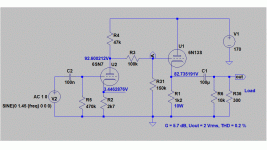Sheldon what do you think is better objective & subjective for 300 ohms headphones: the ECC88 front end or the 7N7 front end?
Might work OK even with current that low. You could try 4mA and a cathode resistor of about 625 (pick a standard resistor value close to this - doesn't need to be exact). Look at the 80V graph line on the plate curve graph. You can see that you can't go much higher than about 5mA and still have enough grid swing at 80V. You can approximate the grid potential (-cathode voltage) between the labeled lines.
I made some simulations and noticed that the overall linearity of the complete amplifier is better with an anode resistor than with a CCS.
The reason is, that the distortion produced by 6SN7 /7N7 will cancel some of the distortion generated at the 6N13S / 6080.
With the CCS the THD is some 0.5...0.6 %, with anode resistor only some 0.2 %.
Attached is my version. I added a voltage divider R3 and R31 to get the operating poin of 6SN7 better, to reduce some gain and to form better operating point for the output tube as well. The frequency response (-1 dB) is some 50...100 kHz.
The operating data is on the schematic.
The reason is, that the distortion produced by 6SN7 /7N7 will cancel some of the distortion generated at the 6N13S / 6080.
With the CCS the THD is some 0.5...0.6 %, with anode resistor only some 0.2 %.
Attached is my version. I added a voltage divider R3 and R31 to get the operating poin of 6SN7 better, to reduce some gain and to form better operating point for the output tube as well. The frequency response (-1 dB) is some 50...100 kHz.
The operating data is on the schematic.
Attachments
Last edited:
Sheldon what do you think is better objective & subjective for 300 ohms headphones: the ECC88 front end or the 7N7 front end?
I have no idea, but I wouldn't expect a night and day difference. If you plan on doing some tube rolling, I wouldn't use a local socket, as there aren't as many choices here. There are lots of 9pin tubes, including an exact replacement for a 6SN7 (6CG7).
I made some simulations and noticed that the overall linearity of the complete amplifier is better with an anode resistor than with a CCS. <snip>
Nice!
Yes, all components are just soldered so needs time to sound OK, I believe the gain is OK. Sound is big and transparent but a little bit harsh (can be no boutique components).
I believe the gain is OK.
So the volume potentiometer does not to be near maximum when listening volume is OK ??
What is your signal source ? Do you know how much is it's output level ?
It depends, I use two sources:
-NoDAC I think 1.2V The Best DAC is no DAC
-Valve Itch I guess 2V Valve Itch phono
-NoDAC I think 1.2V The Best DAC is no DAC
-Valve Itch I guess 2V Valve Itch phono
Yes, but is there any situation when you need to put the volume potentiometer to max. position ?
OK. That is what I wanted to know, because I adjusted the gain of the amplifier intentionally to low value (<6 dB).
It seems that more gain than, say 6...8 dB is not needed.
It seems that more gain than, say 6...8 dB is not needed.
It seems you do well the gain, always can increase or decrease the gain changing the voltage divider values R3 & R31, right?
- Home
- Amplifiers
- Tubes / Valves
- Help CCS for 1.33mA
